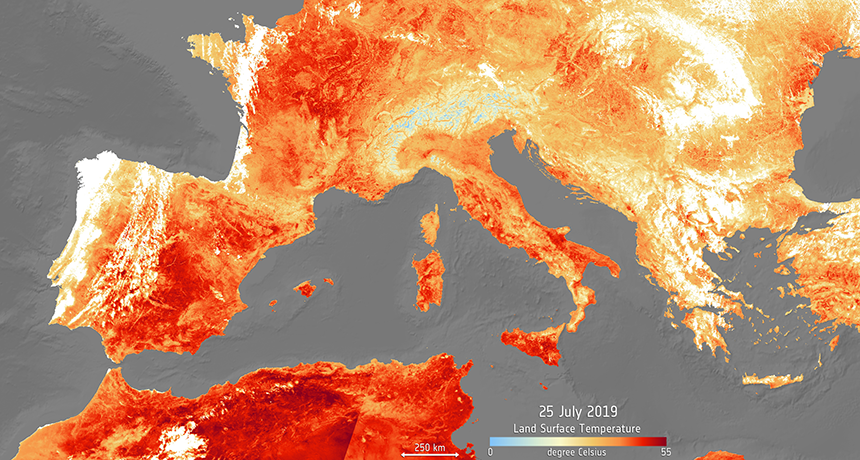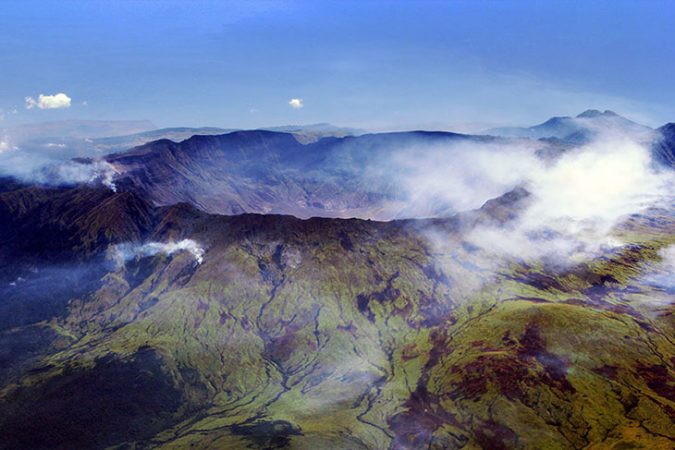Today’s global warming is unlike the last 2,000 years of climate shifts
Previous cooldowns and warm-ups were regional and driven by natural forces

Across 98 percent of the planet, the end of the 20th century saw the hottest temperatures in the last two millennia. Since then, average global temperatures are still increasing, causing record-breaking heat waves such as this one, which hit Europe in late July.
European Space Agency/Flickr (CC BY-SA 2.0)
Temperatures across 98 percent of Earth’s surface were hotter at the end of the 20th century than at any time in the previous 2,000 years.
Such nearly universal warming occurred in lockstep across the planet. And it is unique to this current era, scientists report. There were other well-known cold and warm snaps in the past. They include the Little Ice Age and the Medieval Warm Period. Some people have cited these episodes as evidence that modern warming is nothing out of the ordinary. But those past periods were only regional, not worldwide, new research shows.
Today’s warming is truly global. And nothing like it has been seen in the past 2,000 years. What’s more, temperatures are increasing now much faster than at any time in the last 2,000 years. These conclusions come from a trio of new papers. They examined temperature trends over the last 20 centuries years. The papers were published online July 24 in Nature and Nature Geoscience.
Previous climate ups and downs were mainly driven by natural causes, such as powerful volcanic eruptions, the research shows. Modern warming is due to human-caused emissions of greenhouse gases. These mostly come from the burning of fossil fuels.
The findings are based on newly available global paleoclimate data. (Paleoclimate is another way of saying ancient climate.) They reinforce an inescapable conclusion, says Michael Mann. He is a climate scientist at Penn State University in State College, Penn. He was not involved in the new studies. “The current period of warmth is unprecedented in its global scope in the last 2,000 years,” he says.
Data, data and more data
Raphael Neukom led the team behind the Nature study. He’s a climate scientist at the University of Bern in Switzerland. His team started with many different types of temperature records from around the world.
Modern temp records usually are taken directly with a thermometer or other instrument. To get ancient records, a stand-in — or proxy — for temperature is needed. The new study used proxies derived from tree rings, glacier ice cores, and lake and ocean sediments. Other proxies came from cave deposits such as stalactites and stalagmites. There were other sources of data, too. These included records in historical documents. There were direct temperature measurements collected in some places since the 1800s. And there were also some climate simulations made using computers.
An international group of researchers, the PAGES 2k Consortium, combined all of these data. They produced more than 15,000 different climate reconstructions of the last 2,000 years of global temperatures. Specifically, they looked at A.D. 1 to 2000. Then, they took a close look at the precise timing of warming or cooling within four “climate epochs.” The Roman Warm Period lasted from about A.D. 1 to 300. The Dark Ages Cold Period occurred from 400 to 800. The Medieval Warm Period happened from about 800 to 1200. And the Little Ice Age was from 1300 to 1850.
The same datasets were put into the climate reproductions. But the team then used different methods to process the data and calculate past temperatures. Some methods were simple. Others were complex. Regardless of which was used, the story was the same, the researchers found. None of those past climate epochs were simultaneous, global events.
The Little Ice Age, for example, was a cold snap. It is thought to have lasted from roughly 1350 to 1850. But the deep freezes didn’t occur everywhere at the same time, the new research shows. Northwestern Europe and southeastern North America got their coldest temps during the 17th century. Meanwhile, the central and eastern Pacific Ocean were coldest 200 years earlier, during the 15th century, the team found.

The Medieval Warm Period showed the warmest temps in northwestern Europe and eastern North America during the 11th century. But peak warmth occurred several hundred years later in central South America. And it was several hundred years earlier in the eastern and central Pacific Ocean.
“The traditional understanding is that these [climate epochs, like the Little Ice Age] were global-scale phenomena,” says Nathan Steiger. He’s a climate scientist at Columbia University in New York City. In fact, the data now show, “That’s not the case.”
This finding stands in stark contrast to the team’s conclusions about the current era of warming. Today’s warming is occurring concurrently around the globe. And the hottest temperatures in the study were found to be right at the end of the 20th century. “It is coherent in a way we didn’t experience over the last 2,000 years,” Steiger says.
Because the study’s temperature data go only to 2000, the last two decades weren’t included. But NASA and the National Oceanic and Atmospheric Administration reported in February that nine of the 10 warmest years on record have occurred since 2005. Plus, the last five years were the five hottest on record. Human activities have been repeatedly cited by scientists as the cause of these ongoing record-breaking temps.
Steiger spoke at a news conference on July 22. He noted that the Nature study didn’t specifically mention that the current warming is due to human activities. That was in part because so many previous studies have repeatedly and clearly shown that link. “We don’t need to look at paleoclimate to know that.”
A second study appeared in Nature Geoscience. It does address the question of modern warming more explicitly. That study was authored by Neukom and other members of the PAGES 2k Consortium. It used the same temperature proxies as the Nature study. The team looked at the average global temperature through time.
This revealed that the current rate of warming is much faster than anything observed in the last 2,000 years that can be attributed to natural variability. “It’s another angle to look at the extraordinary nature of current warming,” Neukom said at the news conference.
Volcanoes and greenhouse gases
A third study also appeared in Nature Geoscience. It added another layer of context to the trends. This study looked at what natural forces may have been behind large regional temperature ups and downs, such as the Little Ice Age.
This study was led by University of Bern climate scientist Stefan Brönnimann. In it, the researchers found that powerful volcanic eruptions were the main engine behind large-scale temperature changes in the past.
For instance, there were five powerful eruptions — including the 1815 eruption of Mount Tambora — that occurred toward the end of the Little Ice Age. The eruptions initially led to cooling and climate upheaval. That was followed by a period of recovery. The planet warmed up again. That recovery coincides with the onset of the Industrial Revolution. That’s when people began burning fossil fuels in large amounts. And it’s when greenhouse gases became the primary driver for warming, the researchers note.
Mann notes that the studies’ findings aren’t exactly new ideas. In 1998, he and colleagues published a famous study in Nature. It’s sometimes referred to as the “hockey stick” paper. It revealed a dramatic upward tick in temperatures at the end of the 20th century. This pattern, when plotted through time, takes the shape of a hockey stick. “It’s gratifying that independent, international teams using entirely different approaches have come to virtually identical conclusions,” Mann says.
Raymond Bradley is a climate scientist at the University of Massachusetts Amherst. He coauthored the hockey stick study. He also agrees with Mann. “In that paper, we were widely criticized for saying the last decade was the warmest in the last 1,000 years,” he says. Now scientists can say that the last decade was the warmest in the last 2,000 years.
Bradley adds that the new studies are a valuable addition to his and Mann’s past research. “They’ve done everything right,” he says of the PAGES 2k Consortium.
But the PAGES 2k database of temperature proxies still contains some glaring holes. They exist in places like tropical regions and the oceans. Such data won’t change the underlying storyline. However, filling in the holes could help scientists see global temperature ups and downs even more clearly, Bradley says. Efforts to collect more temperature data from South America are already afoot. Researchers are looking in caves across Brazil and Argentina as well as at ancient trees in the Amazon forest. “That’s exactly what’s needed,” Bradley says.







